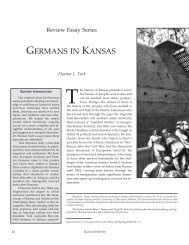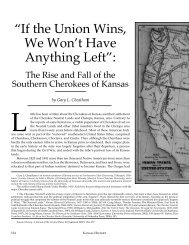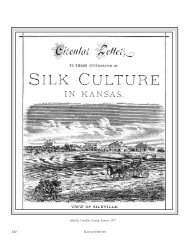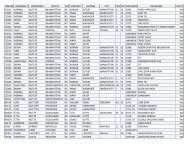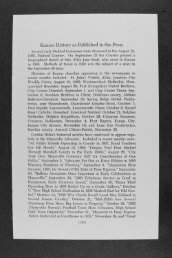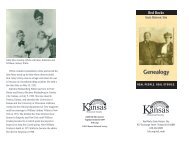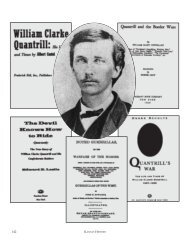July/August 2004 - Kansas Historical Society
July/August 2004 - Kansas Historical Society
July/August 2004 - Kansas Historical Society
Create successful ePaper yourself
Turn your PDF publications into a flip-book with our unique Google optimized e-Paper software.
Excavated post molds show a main structural post with a smaller supporting post.<br />
Excavation units are darkened on this topographic map of the pasture portion of the site.<br />
19<br />
The Fieldwork and<br />
Preliminary Results<br />
A total of seventy-one 1 x 1-meter<br />
units were opened across the site. Fiftyeight<br />
of these were in and around Mound<br />
2, exposing a large portion of a structure<br />
(House 2). Perimeter posts, interior posts,<br />
and features (primarily basins) were<br />
identified as the structure floor was<br />
encountered. While most of the west half<br />
of the structure was exposed, only<br />
portions of the east side were investigated<br />
thoroughly. Areas of the house<br />
that remain unopened include most of the<br />
southeast quadrant of the structure and<br />
much of the north and northeast wall<br />
areas. Additionally, no evidence of an<br />
extended entryway was found, although<br />
with much of the east edge of the house<br />
unexcavated, that is not surprising. Six to<br />
eight excavation units were clustered<br />
outside of the south-central portion of the<br />
house. A single shallow basin was<br />
identified in addition to a sparse scatter of<br />
lithic debris and ceramics. While only a<br />
small sample, this work provides tantalizing<br />
evidence of activities being carried on<br />
outside the house.<br />
It is apparent that the structure only<br />
partially burned. The northwest portion<br />
burned quite heavily, as indicated by<br />
several large interior posts charred<br />
completely to their bases and some large<br />
concentrations of daub and burned roof<br />
debris scattered across the north and<br />
west units. Other structural posts<br />
showed no evidence of burning.<br />
Four large interior posts were<br />
identified, roughly equidistant from the<br />
central hearth. These are thought to<br />
represent the primary central roof<br />
supports. The two large posts on the<br />
north side each had an associated smaller<br />
post on their north side. The northwest<br />
central support showed an interesting<br />
sequence of posts: one large post mold<br />
showed no signs of burning, while three<br />
others (two small and one large) immediately<br />
adjacent to it were heavily burned.<br />
Apparently the large post was removed at<br />
some point, perhaps because it was<br />
beginning to fail, and was replaced by<br />
another large post that burned along with<br />
other nearby posts when the structure<br />
was abandoned.<br />
Within the limits of the house, seven<br />
small features were identified as shallow<br />
basins. For the most part, these features<br />
were nearly devoid of artifacts. One exception<br />
was Feature 77 in the southwest<br />
portion of the house. Here a digging stick<br />
tip, several end scrapers, fragments of<br />
one or more scapula tools, and other debris<br />
were found within or near this large



